Abraliopsis sp. P
Lourdes Burgess and Richard E. YoungIntroduction
Abraliopsis sp. P is found in the tropical Pacific. It is a fairly large species for an Abraliopsis, with males reaching at least 31 mm ML and females at least 40 mm ML. It is very similar to the sympatric Abraliopsis sp. A except, primarily, for the structure of the tentacular club.
Brief diagnosis:
An Abraliopsis (Pfefferiteuthis) ...
- with carpal flap and large keel on club.
- without photophores in central Median Mantle Sector or Medial Head Sector.
Characteristics
In addition to familial characters (listed on the Enoploteuthidae page) and generic characters (listed on the Abraliopsis page), Abraliopsis sp. P has:- Arms
- Arms with two series of hooks and arms I-III with two series of small suckers at tip; suckers more numerous on arms I and least numerous on arms III.
- Arms IV longer in males than females.
- Males with right arm IV hectocotylized and left arm IV highly modified.
- Ventral flap of hectocotylus extends from 5th pair of hooks to base of enlarged arm-tip photophores. Ventral flap bilobed with proximal lobe about twice as high as distal lobe.
- Dorsal flap of hectocotylus extends from most distal hook, becomes abruptly reduced in height, continues distally as low ridge.
- Trabeculae of hectocotylus present on both margins opposite hooks; membrane between trabeculae low or absent in more proximal and distal trabeculae.
- Left arm IV with enlarged ventral protective membrane extending from 2nd pair of hooks nearly to tip of arm. Up to 24 large trabeculae present, up to 2.5 mm long. trabeculae slender, elongate, connected by thin, heavily pigmented membrane. Dorsal protective membrane with short trabeculae and low membrane.
- Bases of arms IV and trabeculae with numerous conical tubercules.
- Left arm IV with longer and more numerous hooks than right arm IV; hooks on both arms differ remarkably in size and arrangement; in some areas dorsal hooks opposite smaller ventral hooks and vice versa.
- Arms I-III with protective membranes on ventral margins, largest on arms III. Dorsal margins with short, stubby trabeculae without membranes except at distal ends of arms.
- Arms III in males with first 1-4 proximal hook of dorsal series much larger than their ventral counterparts. First proximal hook of ventral series equal to or smaller than subsequent hook of same series.
- Arms IV in females with stubby trabeculae on both margins and absent distally.
 Click on an image to view larger version & data in a new window
Click on an image to view larger version & data in a new window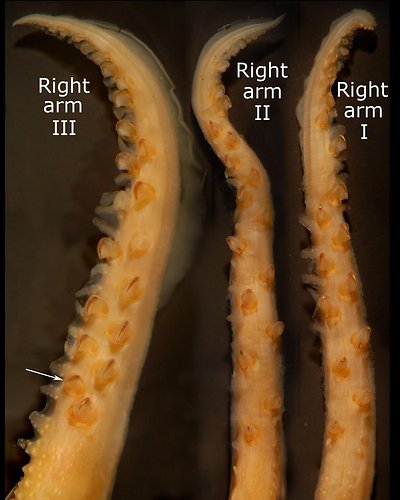
Figure. Oral views of arms of Abraliopsis sp. P, paratype, mature male, 28 mm ML, central Equatorial Pacific. Relative sizes of arms not maintained. Note that the basal sucker of arm III (male only), ventral series (arrow) is smaller, not larger, then the next sucker in the series, an important difference with Abraliopsis sp. A. Photographs by R. Young.
- Arms with two series of hooks and arms I-III with two series of small suckers at tip; suckers more numerous on arms I and least numerous on arms III.
- Tentacles
- Club keel slightly narrower than width of dactylus; extends from proximal end of base of most distal hook of dorsal series to terminal pad.
- Carpal flap extends from opposite carpal area to first ventral hook.
- Carpal pad with 4-5 (rarely 6) suckers and pads.
- Manus with up to 4 pairs of hooks; largest ventral hook over 3 x height of dorsal counterpart.
- Dactylus with 10-11 diagonal rows in four series. Sucker rings smooth, with wide aperatures.
- Photophores
- Ocular photophores: Five ocular photophores; end members about 2x diameter of central photophore; middle three photophores very nearly the same size.
- Integumental photophores: 3 series on ventral head, 6 on ventral mantle.
 Click on an image to view larger version & data in a new window
Click on an image to view larger version & data in a new window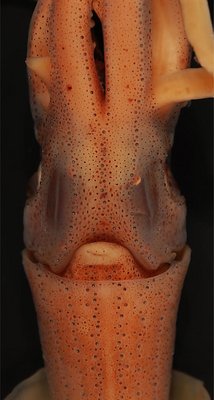
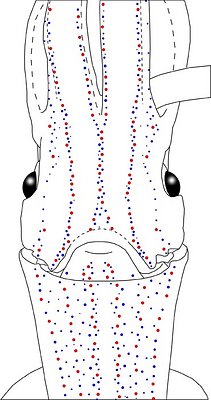
Figure. Ventral view of Abraliopsis sp. P, mature male, 26 mm ML, central equatorial Pacific. Left - Photograph of the preserved squid. Right - Outline drawing from the photograph with all integumental photophores represented by colored dots. Red dots - Comples photophores. Blue dots - Non-complex photophores. Images by R. Young.
Detailed information on the integumental photophores can be found here.
- Ocular photophores: Five ocular photophores; end members about 2x diameter of central photophore; middle three photophores very nearly the same size.
- Viscera
- Spermatangia receptacles: Three receptacles present; two dorsal-collar pockets and one stellate pocket.
- Spermatophore:
- Spermatangia receptacles: Three receptacles present; two dorsal-collar pockets and one stellate pocket.
- Measurements and counts:
CHG 89, sta 29
TC 44, sta. 18
TC 44, sta. 56
TC 44, sta. 56
CHG 89, sta 15
HMS 47, sta. 51
Sex
Male
Female (mated)
Female (mated) Male (mature)
Male (mature) Male
Mantle length
31
34
40
25
28
28
Head width index
36
32
28
36
43
29
Fin Length index
71
71
75
-
75
71
Fin width index
90
94
90
-
93
104
Arm Length index (R/L):
I
48/-
-/47
45/-
44/-
46/-
54 /-
II
55/-
53/-
48/-
56/-
54/-
68/-
III
48/-
53/-
50/-
52/-
50/-
61/-
IV
55/68
56/62
58/63
56/64
61/68
71/93
No. arm hooks, R/L; (suckers):
I
20/-; (22)
17/-; -
18/-; (22)
18/-; (24)
20/-; -
19/-; - II
26/-; (12)
20/-; (7)
21/-; (12)
21/-; (14)
24/-; -
21/-; - III
24/-; (10)
20/-; (6)
21/-; (10)
20/-; (19)
22/-; -
26/-; - IV
31/34
24/25
26/29
27/27
31/36
36/43
Club length index (R/L)
19
24/24
23/-
24/-
21/-
25/-
Club hooks (D/V)(R:L)
4/2/-
3/4; 3/4
4/4
2/4; -
3/3
-
Carpal suckers (R/L)
5/-
4/4
5/-
5/-
6/-
5/-
Comments
More details of the description can be seen here.
Abraliopsis sp. P is very close to Abraliopsis sp. A, Abraliopsis falco and Abraliopsis atlantica. However, A. sp. P and A. sp. A have broadly overlapping distributions. They are separated primarily by features of the tentacular club: A. sp. P with large keel and carpal flap; species with A small keel (short and low) and without a carpal flap. In additionm Abraliopsis sp. P also differs from A. sp. A in lacking an enlarged basal hook on arm III, ventral series, of males. There is also a difference in the size and shape of the largest hooks on the club between these two species.

Figure. Comparison of the club hook size and shape between Abraliopis sp. A and sp. P, side view, all with same magnification. Photographs by R. Young.
The largest hooks of A. sp. P are longer (measured from the base, around the curvature, to the tip of the claw) than those of A. sp. A and the tips of their claws are further removed from the hook shaft. Note that smaller hooks of the ventral series are very similar in the two species although the claw in A. sp. A is more strongly recurved.
Comparisons of all species in the subgenus can be found on the Abraliopsis (Pfefferiteuthis) page.
Distribution
Abraliopsis sp. P is known from the Tropical Central Pacific south of the Hawaiian Islands from about 12°N to 12°S latitude and from about 135° W to 168°W.Title Illustrations

| Scientific Name | Abraliopsis sp. P |
|---|---|
| Location | Central Equatorial Pacific at 0°53'S, 157°58'W |
| Specimen Condition | Preserved |
| Sex | Male |
| Life Cycle Stage | Mature |
| View | Ventral |
| Size | 26 mm ML |
| Collector | Thomas A. Clarke |
| Image Use |
 This media file is licensed under the Creative Commons Attribution License - Version 3.0. This media file is licensed under the Creative Commons Attribution License - Version 3.0.
|
| Copyright |
©

|
About This Page

University of Hawaii, Honolulu, HI, USA
Page copyright © 2013 and
 Page: Tree of Life
Abraliopsis sp. P.
Authored by
Lourdes Burgess and Richard E. Young.
The TEXT of this page is licensed under the
Creative Commons Attribution-NonCommercial License - Version 3.0. Note that images and other media
featured on this page are each governed by their own license, and they may or may not be available
for reuse. Click on an image or a media link to access the media data window, which provides the
relevant licensing information. For the general terms and conditions of ToL material reuse and
redistribution, please see the Tree of Life Copyright
Policies.
Page: Tree of Life
Abraliopsis sp. P.
Authored by
Lourdes Burgess and Richard E. Young.
The TEXT of this page is licensed under the
Creative Commons Attribution-NonCommercial License - Version 3.0. Note that images and other media
featured on this page are each governed by their own license, and they may or may not be available
for reuse. Click on an image or a media link to access the media data window, which provides the
relevant licensing information. For the general terms and conditions of ToL material reuse and
redistribution, please see the Tree of Life Copyright
Policies.
- First online 03 November 2013
- Content changed 03 November 2013
Citing this page:
Burgess, Lourdes and Richard E. Young. 2013. Abraliopsis sp. P. Version 03 November 2013 (temporary). http://tolweb.org/Abraliopsis_sp._P/144275/2013.11.03 in The Tree of Life Web Project, http://tolweb.org/




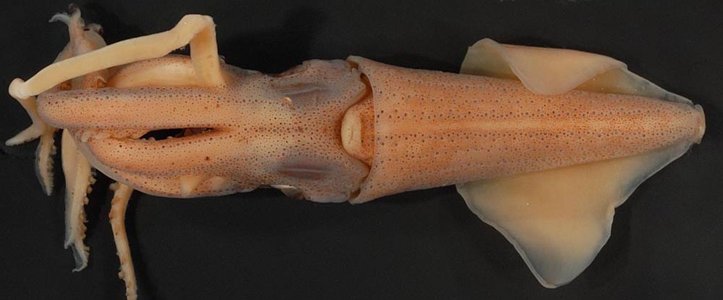
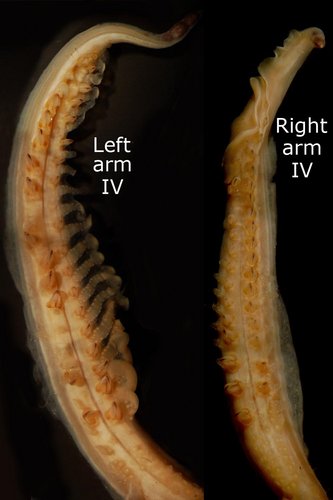






 Go to quick links
Go to quick search
Go to navigation for this section of the ToL site
Go to detailed links for the ToL site
Go to quick links
Go to quick search
Go to navigation for this section of the ToL site
Go to detailed links for the ToL site